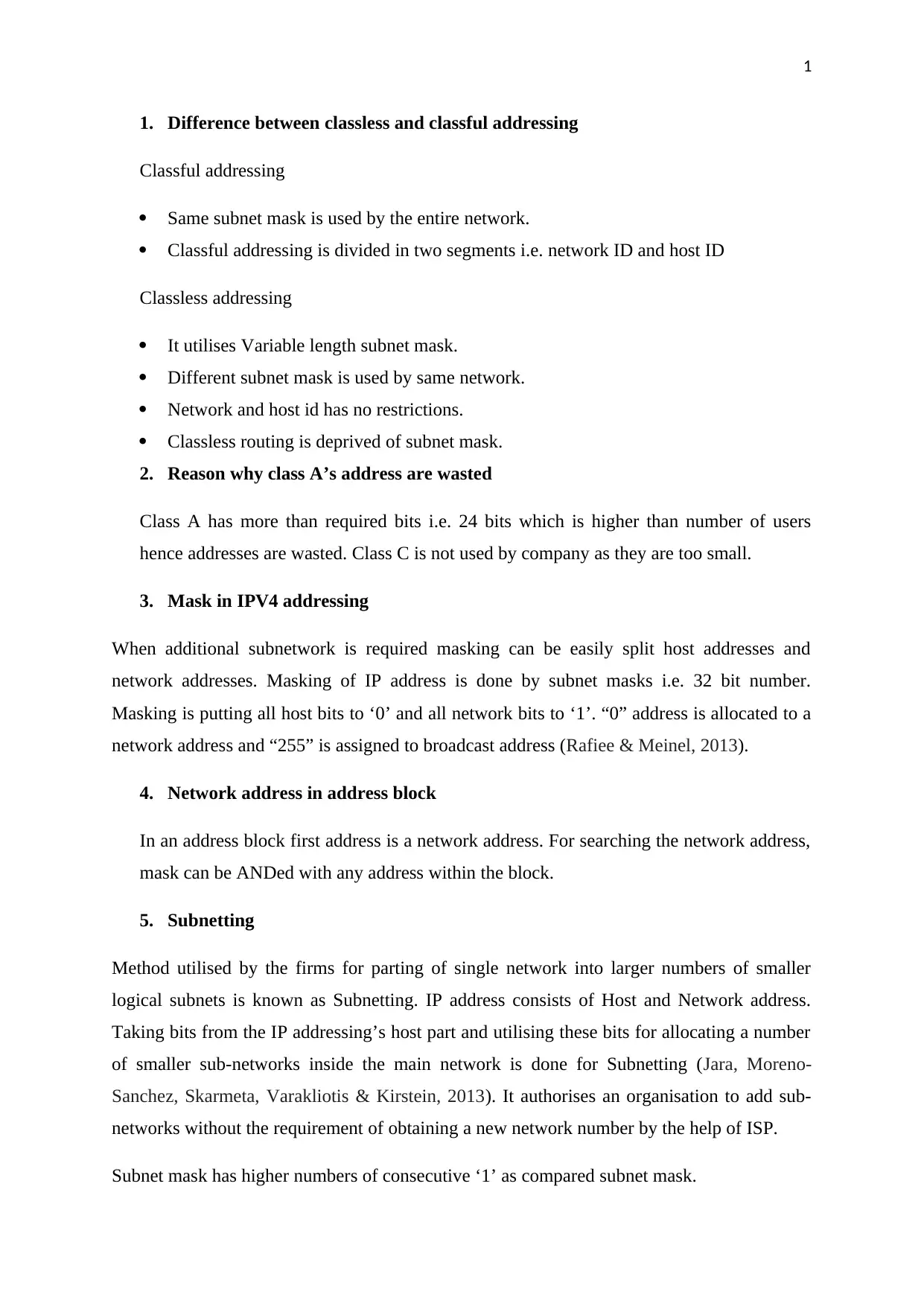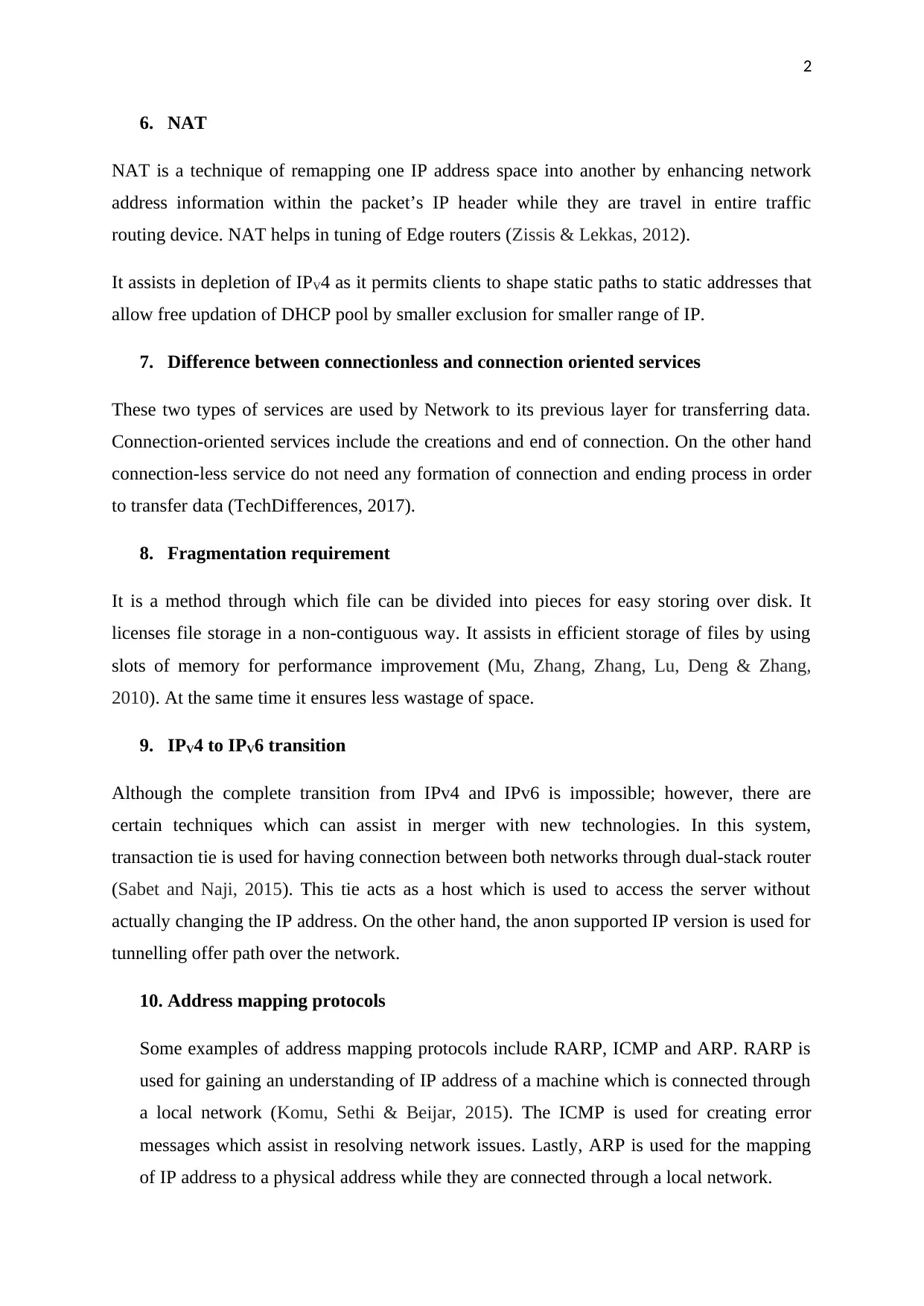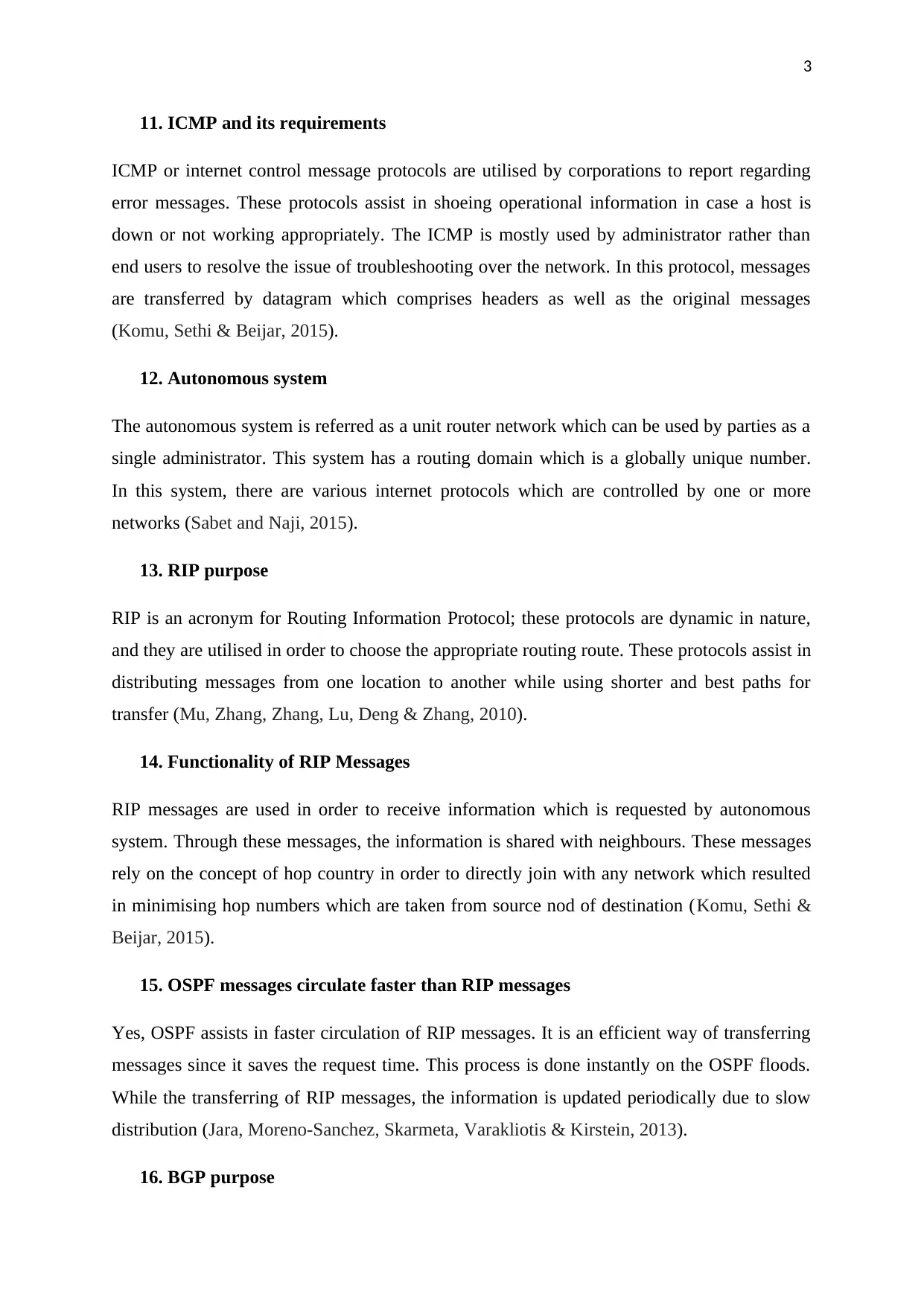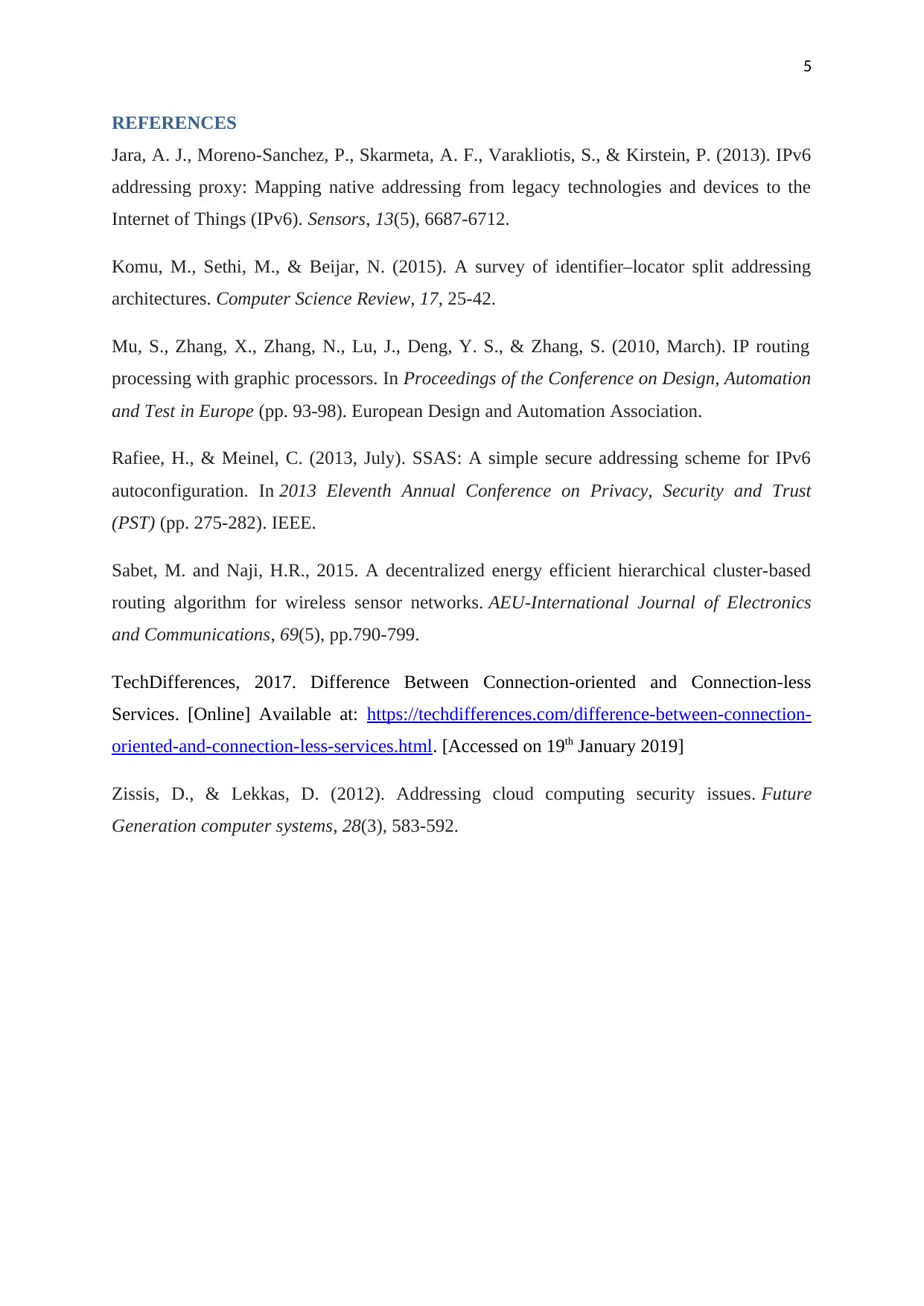Networking: Classless vs Classful Addressing, NAT, Subnetting, RIP, OSPF, BGP, ICMP, Autonomous System
VerifiedAdded on 2023/04/23
|7
|1528
|171
AI Summary
This document explains the difference between classless and classful addressing, NAT, subnetting, RIP, OSPF, BGP, ICMP, and autonomous system. It also discusses the purpose and functionality of these protocols.
Contribute Materials
Your contribution can guide someone’s learning journey. Share your
documents today.

NETWORKING
Secure Best Marks with AI Grader
Need help grading? Try our AI Grader for instant feedback on your assignments.

1
1. Difference between classless and classful addressing
Classful addressing
Same subnet mask is used by the entire network.
Classful addressing is divided in two segments i.e. network ID and host ID
Classless addressing
It utilises Variable length subnet mask.
Different subnet mask is used by same network.
Network and host id has no restrictions.
Classless routing is deprived of subnet mask.
2. Reason why class A’s address are wasted
Class A has more than required bits i.e. 24 bits which is higher than number of users
hence addresses are wasted. Class C is not used by company as they are too small.
3. Mask in IPV4 addressing
When additional subnetwork is required masking can be easily split host addresses and
network addresses. Masking of IP address is done by subnet masks i.e. 32 bit number.
Masking is putting all host bits to ‘0’ and all network bits to ‘1’. “0” address is allocated to a
network address and “255” is assigned to broadcast address (Rafiee & Meinel, 2013).
4. Network address in address block
In an address block first address is a network address. For searching the network address,
mask can be ANDed with any address within the block.
5. Subnetting
Method utilised by the firms for parting of single network into larger numbers of smaller
logical subnets is known as Subnetting. IP address consists of Host and Network address.
Taking bits from the IP addressing’s host part and utilising these bits for allocating a number
of smaller sub-networks inside the main network is done for Subnetting (Jara, Moreno-
Sanchez, Skarmeta, Varakliotis & Kirstein, 2013). It authorises an organisation to add sub-
networks without the requirement of obtaining a new network number by the help of ISP.
Subnet mask has higher numbers of consecutive ‘1’ as compared subnet mask.
1. Difference between classless and classful addressing
Classful addressing
Same subnet mask is used by the entire network.
Classful addressing is divided in two segments i.e. network ID and host ID
Classless addressing
It utilises Variable length subnet mask.
Different subnet mask is used by same network.
Network and host id has no restrictions.
Classless routing is deprived of subnet mask.
2. Reason why class A’s address are wasted
Class A has more than required bits i.e. 24 bits which is higher than number of users
hence addresses are wasted. Class C is not used by company as they are too small.
3. Mask in IPV4 addressing
When additional subnetwork is required masking can be easily split host addresses and
network addresses. Masking of IP address is done by subnet masks i.e. 32 bit number.
Masking is putting all host bits to ‘0’ and all network bits to ‘1’. “0” address is allocated to a
network address and “255” is assigned to broadcast address (Rafiee & Meinel, 2013).
4. Network address in address block
In an address block first address is a network address. For searching the network address,
mask can be ANDed with any address within the block.
5. Subnetting
Method utilised by the firms for parting of single network into larger numbers of smaller
logical subnets is known as Subnetting. IP address consists of Host and Network address.
Taking bits from the IP addressing’s host part and utilising these bits for allocating a number
of smaller sub-networks inside the main network is done for Subnetting (Jara, Moreno-
Sanchez, Skarmeta, Varakliotis & Kirstein, 2013). It authorises an organisation to add sub-
networks without the requirement of obtaining a new network number by the help of ISP.
Subnet mask has higher numbers of consecutive ‘1’ as compared subnet mask.

2
6. NAT
NAT is a technique of remapping one IP address space into another by enhancing network
address information within the packet’s IP header while they are travel in entire traffic
routing device. NAT helps in tuning of Edge routers (Zissis & Lekkas, 2012).
It assists in depletion of IPV4 as it permits clients to shape static paths to static addresses that
allow free updation of DHCP pool by smaller exclusion for smaller range of IP.
7. Difference between connectionless and connection oriented services
These two types of services are used by Network to its previous layer for transferring data.
Connection-oriented services include the creations and end of connection. On the other hand
connection-less service do not need any formation of connection and ending process in order
to transfer data (TechDifferences, 2017).
8. Fragmentation requirement
It is a method through which file can be divided into pieces for easy storing over disk. It
licenses file storage in a non-contiguous way. It assists in efficient storage of files by using
slots of memory for performance improvement (Mu, Zhang, Zhang, Lu, Deng & Zhang,
2010). At the same time it ensures less wastage of space.
9. IPV4 to IPV6 transition
Although the complete transition from IPv4 and IPv6 is impossible; however, there are
certain techniques which can assist in merger with new technologies. In this system,
transaction tie is used for having connection between both networks through dual-stack router
(Sabet and Naji, 2015). This tie acts as a host which is used to access the server without
actually changing the IP address. On the other hand, the anon supported IP version is used for
tunnelling offer path over the network.
10. Address mapping protocols
Some examples of address mapping protocols include RARP, ICMP and ARP. RARP is
used for gaining an understanding of IP address of a machine which is connected through
a local network (Komu, Sethi & Beijar, 2015). The ICMP is used for creating error
messages which assist in resolving network issues. Lastly, ARP is used for the mapping
of IP address to a physical address while they are connected through a local network.
6. NAT
NAT is a technique of remapping one IP address space into another by enhancing network
address information within the packet’s IP header while they are travel in entire traffic
routing device. NAT helps in tuning of Edge routers (Zissis & Lekkas, 2012).
It assists in depletion of IPV4 as it permits clients to shape static paths to static addresses that
allow free updation of DHCP pool by smaller exclusion for smaller range of IP.
7. Difference between connectionless and connection oriented services
These two types of services are used by Network to its previous layer for transferring data.
Connection-oriented services include the creations and end of connection. On the other hand
connection-less service do not need any formation of connection and ending process in order
to transfer data (TechDifferences, 2017).
8. Fragmentation requirement
It is a method through which file can be divided into pieces for easy storing over disk. It
licenses file storage in a non-contiguous way. It assists in efficient storage of files by using
slots of memory for performance improvement (Mu, Zhang, Zhang, Lu, Deng & Zhang,
2010). At the same time it ensures less wastage of space.
9. IPV4 to IPV6 transition
Although the complete transition from IPv4 and IPv6 is impossible; however, there are
certain techniques which can assist in merger with new technologies. In this system,
transaction tie is used for having connection between both networks through dual-stack router
(Sabet and Naji, 2015). This tie acts as a host which is used to access the server without
actually changing the IP address. On the other hand, the anon supported IP version is used for
tunnelling offer path over the network.
10. Address mapping protocols
Some examples of address mapping protocols include RARP, ICMP and ARP. RARP is
used for gaining an understanding of IP address of a machine which is connected through
a local network (Komu, Sethi & Beijar, 2015). The ICMP is used for creating error
messages which assist in resolving network issues. Lastly, ARP is used for the mapping
of IP address to a physical address while they are connected through a local network.

3
11. ICMP and its requirements
ICMP or internet control message protocols are utilised by corporations to report regarding
error messages. These protocols assist in shoeing operational information in case a host is
down or not working appropriately. The ICMP is mostly used by administrator rather than
end users to resolve the issue of troubleshooting over the network. In this protocol, messages
are transferred by datagram which comprises headers as well as the original messages
(Komu, Sethi & Beijar, 2015).
12. Autonomous system
The autonomous system is referred as a unit router network which can be used by parties as a
single administrator. This system has a routing domain which is a globally unique number.
In this system, there are various internet protocols which are controlled by one or more
networks (Sabet and Naji, 2015).
13. RIP purpose
RIP is an acronym for Routing Information Protocol; these protocols are dynamic in nature,
and they are utilised in order to choose the appropriate routing route. These protocols assist in
distributing messages from one location to another while using shorter and best paths for
transfer (Mu, Zhang, Zhang, Lu, Deng & Zhang, 2010).
14. Functionality of RIP Messages
RIP messages are used in order to receive information which is requested by autonomous
system. Through these messages, the information is shared with neighbours. These messages
rely on the concept of hop country in order to directly join with any network which resulted
in minimising hop numbers which are taken from source nod of destination (Komu, Sethi &
Beijar, 2015).
15. OSPF messages circulate faster than RIP messages
Yes, OSPF assists in faster circulation of RIP messages. It is an efficient way of transferring
messages since it saves the request time. This process is done instantly on the OSPF floods.
While the transferring of RIP messages, the information is updated periodically due to slow
distribution (Jara, Moreno-Sanchez, Skarmeta, Varakliotis & Kirstein, 2013).
16. BGP purpose
11. ICMP and its requirements
ICMP or internet control message protocols are utilised by corporations to report regarding
error messages. These protocols assist in shoeing operational information in case a host is
down or not working appropriately. The ICMP is mostly used by administrator rather than
end users to resolve the issue of troubleshooting over the network. In this protocol, messages
are transferred by datagram which comprises headers as well as the original messages
(Komu, Sethi & Beijar, 2015).
12. Autonomous system
The autonomous system is referred as a unit router network which can be used by parties as a
single administrator. This system has a routing domain which is a globally unique number.
In this system, there are various internet protocols which are controlled by one or more
networks (Sabet and Naji, 2015).
13. RIP purpose
RIP is an acronym for Routing Information Protocol; these protocols are dynamic in nature,
and they are utilised in order to choose the appropriate routing route. These protocols assist in
distributing messages from one location to another while using shorter and best paths for
transfer (Mu, Zhang, Zhang, Lu, Deng & Zhang, 2010).
14. Functionality of RIP Messages
RIP messages are used in order to receive information which is requested by autonomous
system. Through these messages, the information is shared with neighbours. These messages
rely on the concept of hop country in order to directly join with any network which resulted
in minimising hop numbers which are taken from source nod of destination (Komu, Sethi &
Beijar, 2015).
15. OSPF messages circulate faster than RIP messages
Yes, OSPF assists in faster circulation of RIP messages. It is an efficient way of transferring
messages since it saves the request time. This process is done instantly on the OSPF floods.
While the transferring of RIP messages, the information is updated periodically due to slow
distribution (Jara, Moreno-Sanchez, Skarmeta, Varakliotis & Kirstein, 2013).
16. BGP purpose
Secure Best Marks with AI Grader
Need help grading? Try our AI Grader for instant feedback on your assignments.

4
The main objective of the Border gateway protocol or BGP is to connect one system with
another. This protocol achieves this objective by offering stability over network permitting
the connected routers to send packets by adopting an appropriate path (Zissis & Lekkas,
2012).
17. Distance vector against link state routing method
There are two factors which play a crucial role in linking state routing needs of all routers to
know its path which includes distance of distance and the distance of path (Rafiee & Meinel,
2013).
The main objective of the Border gateway protocol or BGP is to connect one system with
another. This protocol achieves this objective by offering stability over network permitting
the connected routers to send packets by adopting an appropriate path (Zissis & Lekkas,
2012).
17. Distance vector against link state routing method
There are two factors which play a crucial role in linking state routing needs of all routers to
know its path which includes distance of distance and the distance of path (Rafiee & Meinel,
2013).

5
REFERENCES
Jara, A. J., Moreno-Sanchez, P., Skarmeta, A. F., Varakliotis, S., & Kirstein, P. (2013). IPv6
addressing proxy: Mapping native addressing from legacy technologies and devices to the
Internet of Things (IPv6). Sensors, 13(5), 6687-6712.
Komu, M., Sethi, M., & Beijar, N. (2015). A survey of identifier–locator split addressing
architectures. Computer Science Review, 17, 25-42.
Mu, S., Zhang, X., Zhang, N., Lu, J., Deng, Y. S., & Zhang, S. (2010, March). IP routing
processing with graphic processors. In Proceedings of the Conference on Design, Automation
and Test in Europe (pp. 93-98). European Design and Automation Association.
Rafiee, H., & Meinel, C. (2013, July). SSAS: A simple secure addressing scheme for IPv6
autoconfiguration. In 2013 Eleventh Annual Conference on Privacy, Security and Trust
(PST) (pp. 275-282). IEEE.
Sabet, M. and Naji, H.R., 2015. A decentralized energy efficient hierarchical cluster-based
routing algorithm for wireless sensor networks. AEU-International Journal of Electronics
and Communications, 69(5), pp.790-799.
TechDifferences, 2017. Difference Between Connection-oriented and Connection-less
Services. [Online] Available at: https://techdifferences.com/difference-between-connection-
oriented-and-connection-less-services.html. [Accessed on 19th January 2019]
Zissis, D., & Lekkas, D. (2012). Addressing cloud computing security issues. Future
Generation computer systems, 28(3), 583-592.
REFERENCES
Jara, A. J., Moreno-Sanchez, P., Skarmeta, A. F., Varakliotis, S., & Kirstein, P. (2013). IPv6
addressing proxy: Mapping native addressing from legacy technologies and devices to the
Internet of Things (IPv6). Sensors, 13(5), 6687-6712.
Komu, M., Sethi, M., & Beijar, N. (2015). A survey of identifier–locator split addressing
architectures. Computer Science Review, 17, 25-42.
Mu, S., Zhang, X., Zhang, N., Lu, J., Deng, Y. S., & Zhang, S. (2010, March). IP routing
processing with graphic processors. In Proceedings of the Conference on Design, Automation
and Test in Europe (pp. 93-98). European Design and Automation Association.
Rafiee, H., & Meinel, C. (2013, July). SSAS: A simple secure addressing scheme for IPv6
autoconfiguration. In 2013 Eleventh Annual Conference on Privacy, Security and Trust
(PST) (pp. 275-282). IEEE.
Sabet, M. and Naji, H.R., 2015. A decentralized energy efficient hierarchical cluster-based
routing algorithm for wireless sensor networks. AEU-International Journal of Electronics
and Communications, 69(5), pp.790-799.
TechDifferences, 2017. Difference Between Connection-oriented and Connection-less
Services. [Online] Available at: https://techdifferences.com/difference-between-connection-
oriented-and-connection-less-services.html. [Accessed on 19th January 2019]
Zissis, D., & Lekkas, D. (2012). Addressing cloud computing security issues. Future
Generation computer systems, 28(3), 583-592.

6
1 out of 7
Related Documents
Your All-in-One AI-Powered Toolkit for Academic Success.
+13062052269
info@desklib.com
Available 24*7 on WhatsApp / Email
![[object Object]](/_next/static/media/star-bottom.7253800d.svg)
Unlock your academic potential
© 2024 | Zucol Services PVT LTD | All rights reserved.





